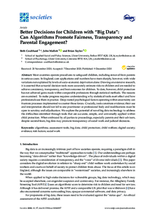Abstract: Most countries operate procedures to safeguard children, including removal from parents in serious cases. In England, care applications and numbers have risen sharply, however, with wide variations not explained by levels of socio-economic deprivation alone. Drawing on extensive research, it is asserted that actuarial decision tools more accurately estimate risks to children and are needed to achieve consistency, transparency, and best outcomes for children. To date, however, child protection has not achieved gains made within comparable professions through statistical methods. The reasons are examined. To make progress requires understanding why statistical tools exert effect and how professionals use them in practice. Deep-rooted psychological factors operating within uncertainty can frustrate processes implemented to counter those forces. Crucially, tools constitute evidence; their use and interpretation should not fall to one practitioner or professional body and modifications must be open to scrutiny and adjudication. We explore the potential of novel big data technology to address the difficulties identified through tools that are accurate, simple, and universally applied within child protection. When embraced by all parties to proceedings, especially parents and their advisors, despite societal fears, big data may promote transparency of social work and judicial decisions.

